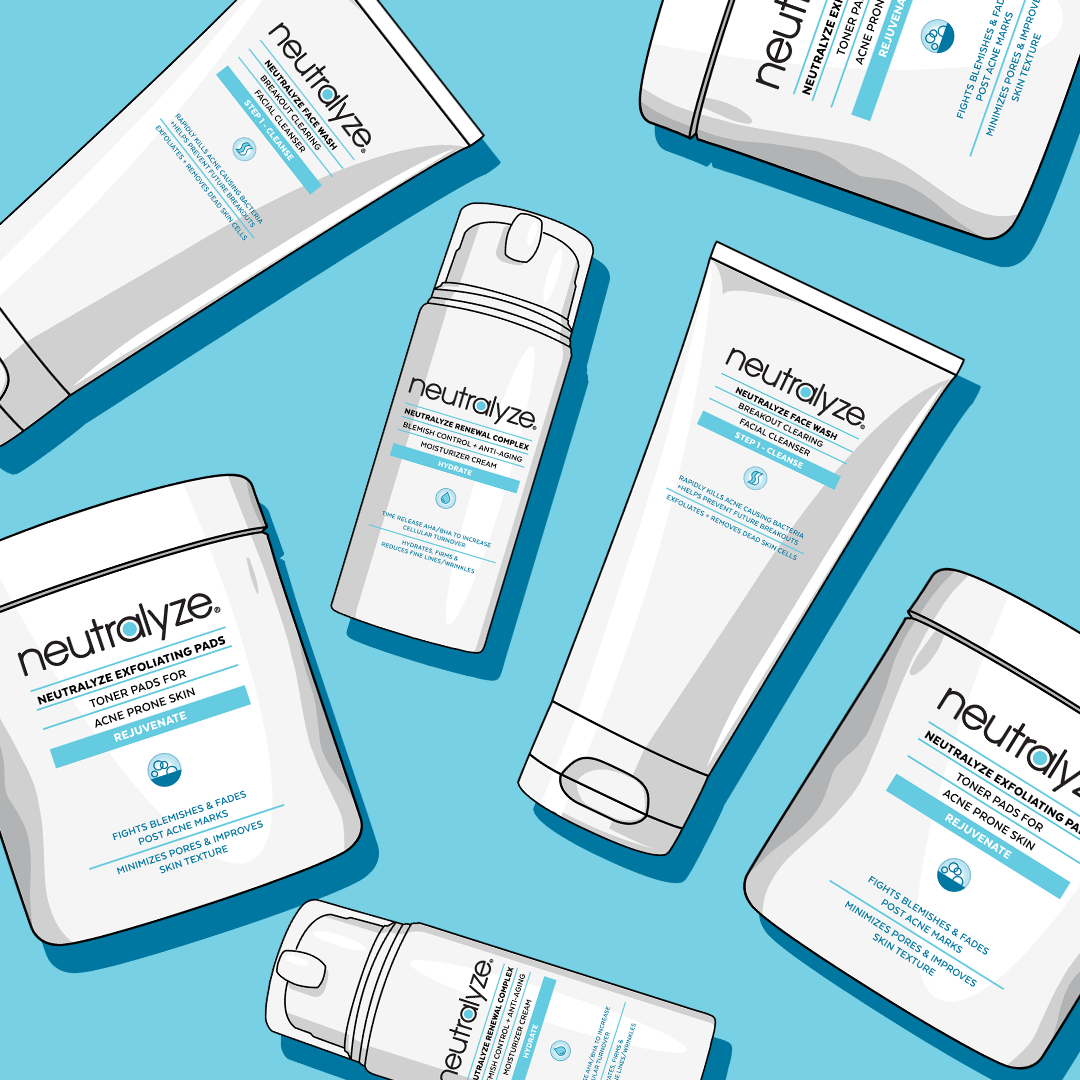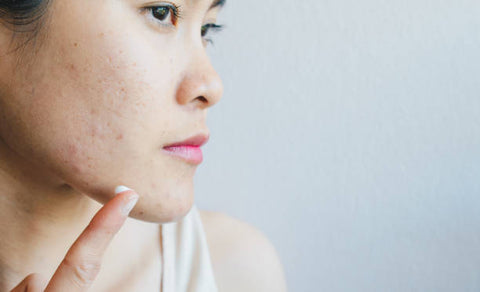How to Care for Acne Prone Skin

Acne breakouts can be very distressing, especially when they occur regularly. While triggers for acne are typically the same for most people, some tend to experience breakouts with more frequency. This may be due to certain lifestyle factors like exposure to pollution, stress, and lack of sleep. But sometimes, this may be due to biological factors like larger pores or overactive oil glands.
What Does Acne-Prone Skin Mean?
Acne-prone skin refers to the skin type that is especially susceptible to blemishes. This does not only include people who have a history of acne, but also those who may have very few lesions but can experience sudden increases in inflammatory lesions or breakouts. People with this skin type are more vulnerable to extrinsic factors that can aggravate existing skin conditions or generate new lesions.
While scientists have yet to establish why certain people are more prone to acne breakouts, studies suggest that genetics may play a huge role in that, alongside environmental factors.
Often associated with puberty, acne is triggered in part by hormonal changes. This is why women are more likely to develop acne as their bodies experience hormonal fluctuations during menstruation, pregnancy, and menopause. Meanwhile, men may develop acne when they experience physical or emotional stress and when they take medications that can cause changes in their hormonal balance.
If you’re experiencing consistent breakouts, you may have acne-prone skin.
What Causes Acne Breakouts?
A variety of factors come into play when it comes to acne breakouts, both intrinsic and extrinsic. Some people are more prone to breakouts due to their genetic predisposition, although exposure to extrinsic factors can also increase the likelihood of breakouts.
Intrinsic Factors
Intrinsic or biological factors pertain to genetics, health conditions, hormones, and reactions to medications. These factors are oftentimes beyond our control, necessitating treatments or alternatives to help address them.
The results of a study on the influence of genetics and environmental factors on acne revealed that 81% of the variance of the disease can be attributed to genetic factors. These may include inherited traits like large pores, overproduction of dead skin cells, oily skin, and a susceptible immune system. Some people may have inherited a tendency to produce excess androgen in their bodies, which can lead to hormone-related flare-ups.
Another study revealed that having parents or first-degree relatives who has or had acne increases the risk of developing the condition. A positive history may also increase the risk of acne severity.
If one or both of your parents suffered or suffer from acne, it’s important to consult with a dermatologist to learn about your skin type. This will help equip you with the knowledge on how to address flare-ups. You can also talk to your parents and ask them how they dealt with them. If their solutions worked for them, there is a good chance they would also work for you.
Fluctuations in hormone levels can trigger or aggravate acne. An increase in the hormone androgen, which is common during puberty, can trigger the sebaceous glands to produce more sebum, thereby increasing the risk of developing acne.
Increased levels of androgen leading to acne can also be found in the cases of pregnant women who experience breakouts during the first or second trimester of their pregnancy. It also accounts for the late onset acne in menopausal women, although in some cases it is because of the falling levels of estrogen.
Besides pregnancy and menopause, a study revealed that 70% of women experience an intensification of acne symptoms in the week leading up to menstruation.
However, changes in hormones don’t only occur during puberty, menstruation, pregnancy, and menopause. Some health conditions can also cause fluctuations in hormone levels.
Health conditions like polycystic ovarian syndrome (PCOS) may account for the appearance of acne in women who are past their mid-twenties. In this case, acne is only one of the many symptoms. Other symptoms may include irregular menstruation and hirsutism or the abnormal hair growth on your face or body. PCOS is typically characterized by increased androgen levels, chronic anovulation, and formation of cysts.
Congenital adrenal hyperplasia (CAH) is another health condition that can cause increased androgen levels, leading to early onset puberty in both boys and girls. Unlike hyperandrogenism in women, which may present other symptoms, androgen excess in men typically manifests only in the appearance of acne.
Medications can also trigger acne or acne-like symptoms, known as drug-induced acne (DIA). DIA can occur in reaction to certain medications like corticosteroids, lithium, halogens, antiepileptic drugs, some antibiotics, and thyroid hormones.
Drugs that are taken orally, applied topically, or inhaled can produce DIA. Topical products often result in an acne breakout in the chin area in women. On the other hand, oral corticosteroids often manifest in the chest or back area. Unlike true acne, DIA is generally uniform in appearance.
Extrinsic Factors
Extrinsic factors include lifestyle and environmental factors that can affect our health and well-being. As opposed to intrinsic factors, many of these factors are within our control. Although acne-prone skin may be largely hereditary, addressing extrinsic factors can help in limiting breakouts.
If you’re already prone to acne flare-ups, it’s best to avoid foods and drinks that have a high glycemic index (GI). High glycemic foods, like white bread, white rice, bagels, and fries, rapidly raise the sugar levels in your body, leading to an increase in insulin levels to help transport the sugar in your bloodstream. High insulin levels make androgen hormones more active, which increases sebum production, triggering an acne breakout.
Foods rich in omega-6 fatty acids, such as processed snacks, fatty meats, and fast food, are also associated with inflammatory acne. Milk, though low in GI, is also often implicated in acne flare-ups, but so far, there is no conclusive evidence linking the two.
During stressful situations, your body reacts by producing hormones like adrenalin and cortisol, which is advantageous for fight-or-flight situations. However, these days, people are likely experiencing chronic stress due to a wide range of factors, such as frustrations at work, personal problems, and the like.
All these contribute to the production of stress hormones and inflammatory cytokines, which not only dehydrate your skin, but also influence your sebaceous glands to produce more oil, aggravating acne.
Chronic stress can also disrupt your metabolism and sleeping patterns. These can weaken your immune system, making you more susceptible to inflammation. In fact, a 2017 study revealed that the higher the stress levels, the more severe the acne breakouts.
The adverse effects of smoking on skin, like delayed wound healing and accelerated skin aging, are quite well-known. However, smoking has also been found to be linked with acne flare-ups.
In a cross-sectional study of 1,000 women, it was discovered that women who smoke are more likely to develop non-inflammatory acne. This type of acne usually appears on the cheeks and is characterized by blocked pores, large blackheads, and skin-colored bumps, with significantly less inflamed spots.
Smoking can also exacerbate acne by causing oxidative stress to the skin, dehydrating it, leading to increased production of sebum. This contributes to your skin’s susceptibility to bacterial infection.
Airborne pollutants, which include dust, debris, and dirt, can collect on your skin and block your pores. But the most damage can come from the abundance of free radicals in polluted air. Since your skin is your first line of defense, it bears the full brunt of this free radical damage.
Constant exposure to air pollution and UV rays can compromise your skin health, depleting its natural defenses, and lead to inflammation.
Other extrinsic factors that can contribute to the development of acne include the use of abrasive skin products, the use of comedogenic cosmetics, poor sleeping habits, and poor hygienic practices.
Washing your face more than twice a day can also lead to increased sebum production. Frequently touching your face with your hands or your phone when you’re taking a call can promote acne breakouts since you’re transferring acne-causing bacteria to your face.
Treatment and Care
People with acne-prone skin need to take extra care to prevent breakouts. One way you can care for your skin is by being diligent in your skincare routine.
Wash your face twice a day with a mild water-soluble cleanser.
Cleanse your face twice a day, once when you wake up and once before you go to bed. It’s important not to wash too frequently as this may stimulate the production of excess oil and irritate your skin. When washing your face, it’s best to use a water-soluble facial cleanser since it’s gentler on the skin and is less likely to cause irritation compared to its alcohol-based counterpart.
You may also use a face wash for acne-prone skin for deeper cleansing. But be sure to avoid using scrubs and loofah; instead, use your fingertips to gently massage your skin. Rinse your face with lukewarm water and pat dry with a soft, clean towel.
Choose the appropriate treatment solutions.
There are a variety of treatment solutions available today, depending on the major contributing factor to your acne flare-ups. For hormonal imbalances, there are anti-androgen drugs and FDA-approved oral contraceptives. To reduce acne-causing bacteria and inflammation, there are antibiotics that you can take orally and retinoid creams that you can apply topically.
Topical treatment solutions that have been proven effective in addressing acne flare-ups often contain salicylic acid and nitric oxide. Salicylic acid’s anti-microbial, anti-inflammatory, and comedolytic properties make it an effective solution against acne. Meanwhile, nitric oxide prevents inflammation, which when used in tandem with salicylic acid, can promote healing while addressing the root cause of acne.
Use the right moisturizer for acne-prone skin.
Using certain treatment solutions may have a drying effect on your skin. If left unchecked, this can cause irritation and may signal your body to produce more oil. This, in turn, can clog up your pores and cause breakouts.
Moisturizers help prevent this from happening by locking in much-needed moisture in your skin. The best moisturizer for acne-prone skin is one that’s non-comedogenic, oil-free, and won’t clog pores.
For best results, after washing your face, leave some water on your skin for a bit before applying your moisturizer.
Apply sunscreen with at least 30 SPF.
If you’re often out in the sun, it’s important to apply sunscreen. Besides protecting you from harmful UV rays, sunscreen can also prevent skin discoloration and scarring due to acne. Hyperpigmentation after an inflammation is quite common among acne sufferers. A good sunscreen offers photoprotection to keep this from happening.
Be sure to remove sunscreen before you sleep at night.
Consult with your dermatologist.
Acne can be caused by a lot of different factors. If your condition hasn’t improved with medications and lifestyle changes, then you should consult your dermatologist. They can help shed light on what may be causing your flare-ups and prescribe the necessary treatment.
Having acne-prone skin can be frustrating, but understanding the possible causes of your acne can help you find the right way to address flare-ups. With the right treatment solutions and healthy habits, you can effectively care for your acne-prone skin.

